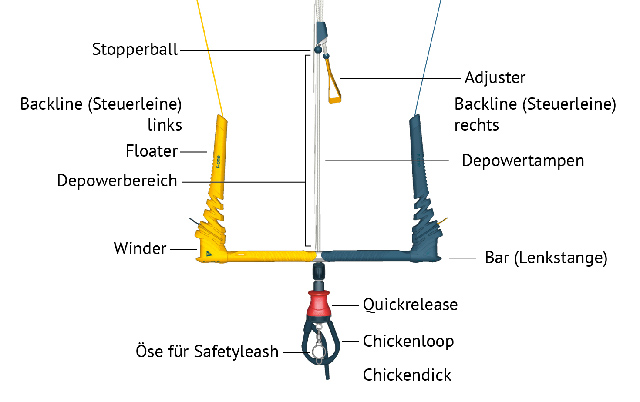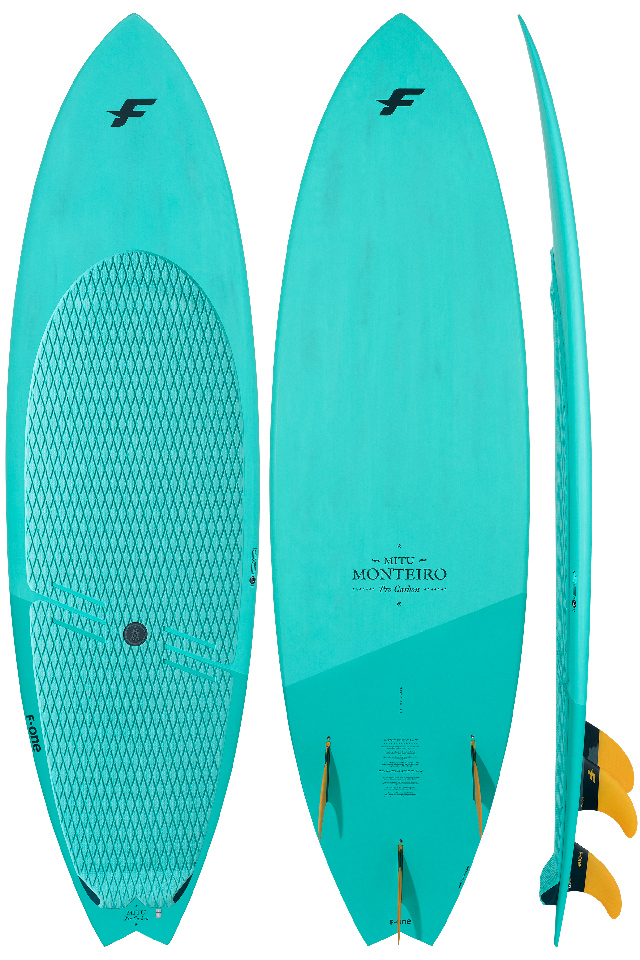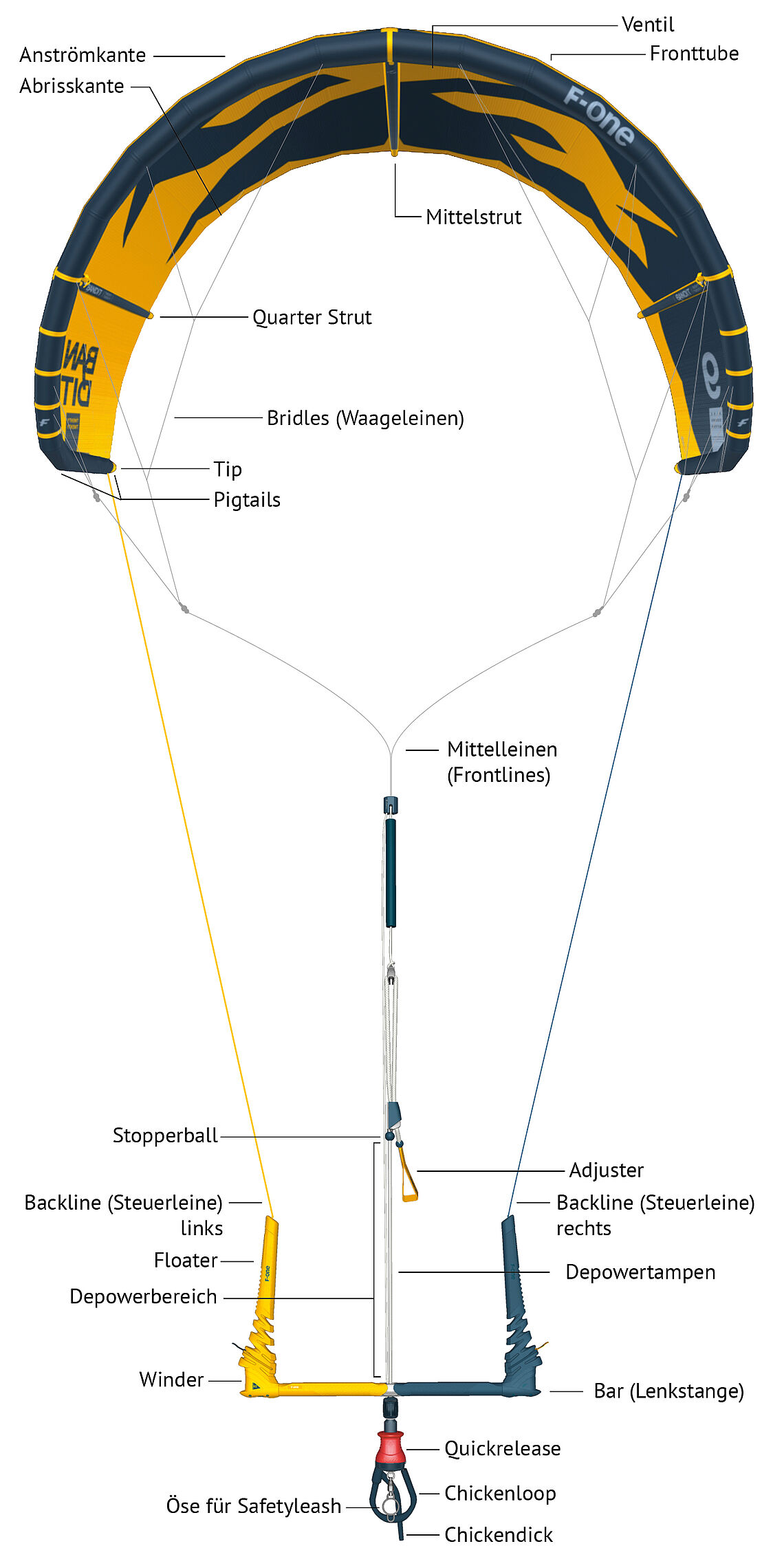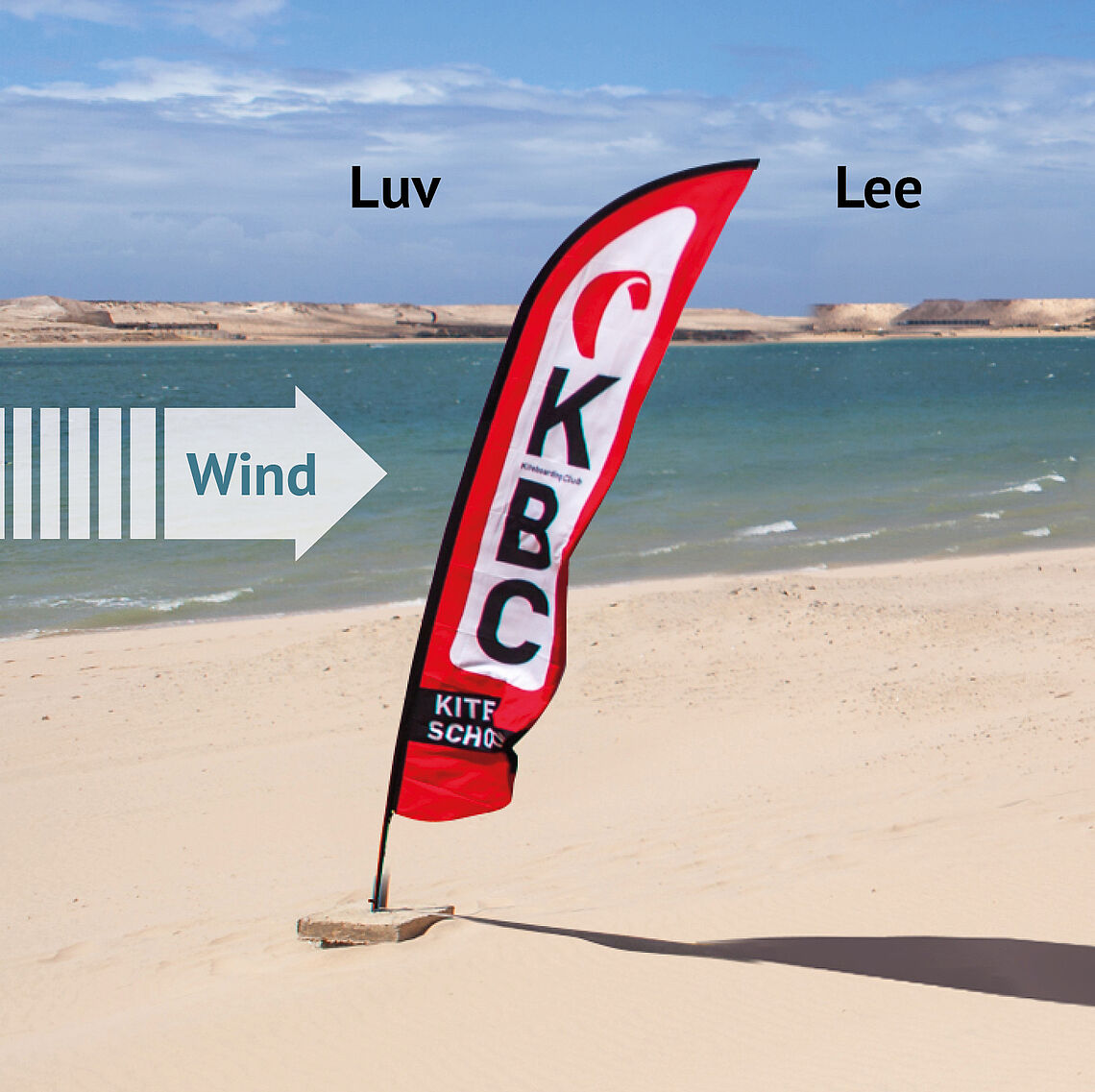Technical terms that every kitesurfer should know
You are standing on the kite beach and only understand chickenloop? Here you will find all the terms so that you also understand the kite language and learn to speak:
5. leash
The additional fifth safety line on the bar, which is attached from the safetyleash in the middle of the front tube. The fifth line provides more safety while kitesurfing. As soon as the kite is released with the quick-release, the kite can rest relaxed and almost powerless on the fifth line and blow out. The kite no longer develops any pulling force on the fifth line. In addition, the fifth line facilitates an easy relaunch out of the water.
A
Adjuster
The ability to fine tune your bar to change the power of the kite by changing the length of the front lines. This is usually done by using the adjustment straps on the front lines centered on the bar, to adjust the power (angle of attack of the kite). Serves to depower or anpower the kite and allows the adjustment of the pull power to different wind forces. Works mostly according to the "pull-pull principle".
B
Backlines
Steering lines that extend from the outer ends of the bar, which are attached to the trailing edge of the kite. They initiate the steering of the kite.
Bidies
Other word for Twin Tip Board, comes from Bi-Directional, so a symmetrically cut board that can ride in both directions, or does not need to be turned to change direction.
Boardleash
Safety line between kiter and kiteboard, usually directional surfboard. Thus, the kitesurfer does not lose the board after falls and it can be pulled back on the leash. The board leash is very controversial because of its risk of injury: In case of a fall, the board can act like an anchor and if the tension of the leash is too high, it can be thrown back to the kitesurfer. This can cause massive injuries, often to the head. Therefore, anyone kitesurfing with a board leash should always wear a helmet and an impact protection vest.
C
Chickendick
Short rope that is inserted into the tranpe hook underneath the chicken loop to prevent the chicken loop from accidentally falling off/slipping out.
Chickenloop
The chicken loop is the part of a bar system that connects the bar to the kiter's harness hook. The chickenloop is a loop-shaped tube that is hooked onto the harness hook and then secured with the so-called chickendick against accidental unhooking. The chicken loop is also the essential part of the safety systems used on the bar system. In an emergency, the chickenloop must open easily even when the lines are pulled hard, so that the kiter can separate from the kite and is then only connected to the kite with the safety line.
The opening mechanisms that open the chickloop differ significantly in the safety systems of different manufacturers. Reassembly after a safety release also varies in complexity. Systems that are easy to release, easy to close again and, above all, insensitive to sand and small stones are ideal.
D
Directional
Kiteboards that have only one direction of travel and must be turned to change direction. The first kiteboards were directional boards and descended from the wave surfboard. Today directional boards are mainly used in the wave. In light winds, the surfboard is also a good alternative to big twintips and offers a lot of fun and challenge.
F
Floater
The buoyancy bodies on the outside of the bar, which allow the bar to float and not sink. They are also called "floats".
Flying cloth
Fabric material (usually Dacron) from which the kite cloth is made. It is very durable and resilient.
H
Show of hands
Sign language for communication in kitesurfing, hand signals and movements that are language-independent and can be understood over greater distances. Here you will find an overview of all hand signs, the language of kitesurfers.
Half-wind course
Heading with a course at 90° to the wind, you don't lose altitude, but you don't gain altitude either.
K
Kite
The tube kite is the most common kite system. It consists of a framework of tubes filled with air, the "struts". These give it a certain stability of form. The front tube is the main air chamber. The transverse struts emanate from it at the sides. All struts are inflated with the help of a pump. The valve closes the kite. In some kite systems, the struts are connected internally, so they can be pumped out together - the "one-pump system". Bow kites and delta kites are distinguished by the shape of the tip: Delta Kites run almost pointed, in Bow Kites the front tube runs around to the tip ends in an arrow shape. Both systems have bridle lines that give the kite additional shape stability in the air and distribute the pressure evenly over the front lines. The control lines (backlines) usually differ in color. They grip at the attachment points of the breakaway edge. The center lines, on the other hand, grip at the attachment points of the leading edge.
Kiteloop
With the Kiteloop you rotate your kite with almost maximum steering movement. The term "kiteloop" is usually used to describe a jump in which you rotate your kite completely in the air at least once.
Kite pump
With your kite pump, a piston stroke pump, you pump air into the tubes of your kite. It is a piston-stroke pump that pumps air into the chamber of your kite when you pull and push.
L
Landkite
The practice kite with which you train flight exercises on land. Here you will find a practice kite for the first flight exercises.
Comb linen
After unrolling the lines from the bar, arrange the lines. You can do this very well by holding and loosening them with one hand and passing them through the four spaces between the fingers of the other hand.
O
P
Q
S
Safety Leash
The safety line that connects the fifth or virtual fifth line to the safety mechanism on your kite harness.
Float
The buoyancy bodies on the outside of the bar, which allow the bar to float and not sink. They are also called "floaters".
Shape
The specific shape, or profile, of the board or kite that significantly determines its riding or flying characteristics.
Softkite
A kite that is not inflated like a tube kite, but consists of two layers of cloth and open air chambers. The air, in the chambers stands or circulates and thus provides dimensional stability of the kite. The opposite is a Tubekite.
Spreader
The front part on the harness, which also carries the harness hook and is pleasantly padded for comfortable carrying.
Control lines
Lines that are responsible for steering your kite. They extend from the very ends of your bar to the tips of your kite. They are also called "backlines".
Struts
The cross tubes, which run like ribs between the front tube and the trailing edge and give the Tubekite its classic profile.
Suicide Leash
If you ride with "Suicide Leash", you attach your Safety Leash directly to the Depower Rope. This bears the risk that after release the kite still has a residual pull.
T
Toeside / Frontside
The long edge of the kiteboard to which your toes point. It is opposite the "heelside", the side your verses face.
Trapeze
Belt-like support in the abdominal area with trapeze hook, in which you hook the chickenloop of your kite. This distributes the power of the kite over the center of your body. The kite beginner usually starts with the seat harness (shaped like a pair of pants) and changes to the hip harness (shaped more like a belt) as his riding skills progress.
Trapeze hook
Metal hook on your harness. Here you hook the chicken loop of your kite. This distributes the force of the kite over the trapeze to your body.
V
Virtual 5th leash
Thus, an additional function of one of the two frontlines in a four-line bar is called a safety line (5th line), which connects the kite to you after the 2nd safety line is triggered.
Right of way rules
Internationally recognized rules (e.g. from VDWS and IKO) that regulate the cooperation and special situations on the water. Here you can find the kitesurf right of way rules.
W
Balance Linen
Short intermediate lines directly on the kite - the pull of the frontlines is distributed evenly on the kite here.
Wind window
Area in which the kite flies. The wind window is the quarter of a sphere that represents the zones in which a kite can be controlled. The wind window is divided into the zones wind window edge, soft zone, power zone and zenith.




